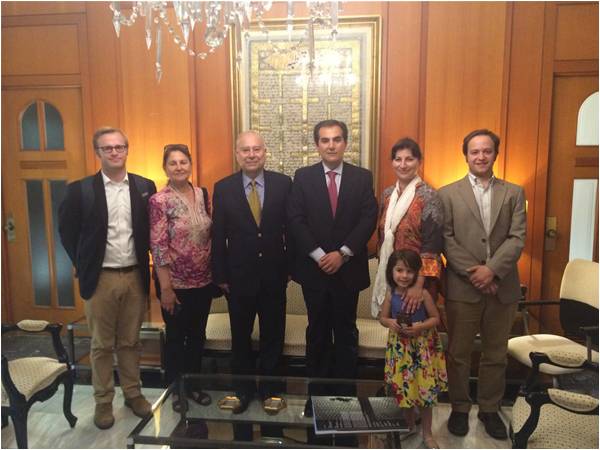
During the time of the Inquisition, you had to have a Christian legacy going back twenty generations to be spared torture and death. If you were found to be Muslim or Jewish even 19 generations ago, the Inquisition would trace your genealogy, show up at your door, confiscate your property, and tell you to convert or leave the country. However, the biggest sacrifice was that you had to leave your children behind who would be forcibly converted and brought up as Catholics. Men and women, Muslim and Jewish alike, were tortured by the Inquisition. No one was spared and no mercy, no compassion was shown. Alas! Under the Inquisition’s reign of terror and in face of the surrender of the Muslim civilization the pulse that throbbed Rehman and Rahim faded away into the thick and dark blankets of history.
What looks strangest though is the forcible insertion of a Cathedral into the mosque. In 1523, the Borges of Southern Madrid had been an inquisitor of Spain so, we were told, he liked the mosque and instead of destroying it like many other mosques were destroyed he inserted the Cathedral in the mosque. The Inquisition destroyed all mosques, though we were told that the Cathedral within saved the destruction of the Cordoba Mosque once it was in the hands of Christians. One hundred pillars were removed from the 1013 columns to build the cathedral. The mosque was darkened intentionally and the Catholic bishop built a huge cathedral in the shape of a cross with huge windows to let in light to symbolize the light of his religion. Ironically, despite the blowing out of the light of knowledge and tolerance in Al Andalus and the subsequent intolerance of the Inquisition, in the Bishop’s view his expression of religion was light as opposed to the darkness of those conquered. Yet his own king who had not seen either the mosque or the insertion gave permission for building this cathedral inside the mosque but when he visited three years later, for the first time, he expressed his revulsion at the insertion, “Do you think I would have given permission had I known that you were going to damage this unparalleled piece of architecture? I can find churches like this one everywhere, but a mosque such as this may never be built again.” The Christian king did not like it.
[quote]800 years of Muslim rule were reduced to a few negative sentences[/quote]
No believer could remain dry-eyed at the realization of this loss of a great civilization that gave knowledge to the world, symbolized by this mosque, which was now unfairly re-portrayed as dark. Inside the cathedral, a horseman, St James (Santiago Matamoros) – the patron saint of Spain for 160 years, tramples the head of a Moor (Muslim) under the hooves of his horse. Pictures of Jesus – slain and hurt with cuts and blood surround us in all the churches built around the mosque; in one picture Mary has a sword inserted in her body as if the source of her connection with her baby – Jesus – has been stung with the arrow by the act of Jesus’ crucification; in another picture St Pablo or St Peter holds a sword in one hand and a bible in the other (an image of the self often, unfortunately, projected onto “the Other”, here sadly Muslims).
In the evening, we went out for a walk and on a plaque opposite the mosque it was written that this building is now a cathedral but the “primitive” mosque was built by Muslims. This terminology seemed intentionally offensive. Several people we spoke with said the spirit of the Inquisition has not fully left yet and there was an attempt to “erase” the Muslim past in Cordoba specifically and in Spain generally. They did not teach this period in schools or at best, 800 years of Muslim rule were reduced to a few negative sentences.
There was trouble for Muslims last year who tried to pray in the mosque. They were arrested and thrown out. The guards were aggressive, uncompromising, and watchful to them. As tourists poured in to the 8:00-9:00 am period when the mosque entrance was free, I promised I would go there again before breakfast and read the ninety-nine names of God in the mosque in Cordoba – I did this discreetly in my heart whilst walking alongside the tourists; tears of humility and connection to God flowing to the ground.
Before leaving Cordoba, we met the Bishops of the Cathedral and asked how peaceful relations could be possible and what were the challenges in their own community. The dialogue resulted in better understanding. At the hotel entrance – a hotel called “La Conquestidor” – the Re-conquest of Cordoba from Muslims – we saw a Muslim girl with her little son – I said, “Salam u Alaikum”. She was in a hijab and entering the hotel facing the Mezquita or mosque. We asked her what the mosque meant to her, she said it was very sad then choked and began to cry. A total stranger in the first five minutes of our meeting began to break down at the thought of Al Andalus, and what great intellectual heights and position in her words “we [had] lost”. I empathized. Many have shed tears and written poems, as Iqbal did, to the Masjid-e-Qurtuba or “Mezquita” as it is called in Spanish. As one scholar said, either this period of Al Andalus can be a period used to make war or it can be seen by others to make peace. Let us hope and pray that we can see it as an example of how we can revive a much-needed spirit in today’s world of understanding, knowledge, and peace.
Dr Amineh Hoti is the director of the Centre for Dialogue and Action at FC College in Lahore. For details on the project Journey into Europe, please see journeyintoeurope.com
What looks strangest though is the forcible insertion of a Cathedral into the mosque. In 1523, the Borges of Southern Madrid had been an inquisitor of Spain so, we were told, he liked the mosque and instead of destroying it like many other mosques were destroyed he inserted the Cathedral in the mosque. The Inquisition destroyed all mosques, though we were told that the Cathedral within saved the destruction of the Cordoba Mosque once it was in the hands of Christians. One hundred pillars were removed from the 1013 columns to build the cathedral. The mosque was darkened intentionally and the Catholic bishop built a huge cathedral in the shape of a cross with huge windows to let in light to symbolize the light of his religion. Ironically, despite the blowing out of the light of knowledge and tolerance in Al Andalus and the subsequent intolerance of the Inquisition, in the Bishop’s view his expression of religion was light as opposed to the darkness of those conquered. Yet his own king who had not seen either the mosque or the insertion gave permission for building this cathedral inside the mosque but when he visited three years later, for the first time, he expressed his revulsion at the insertion, “Do you think I would have given permission had I known that you were going to damage this unparalleled piece of architecture? I can find churches like this one everywhere, but a mosque such as this may never be built again.” The Christian king did not like it.
[quote]800 years of Muslim rule were reduced to a few negative sentences[/quote]
No believer could remain dry-eyed at the realization of this loss of a great civilization that gave knowledge to the world, symbolized by this mosque, which was now unfairly re-portrayed as dark. Inside the cathedral, a horseman, St James (Santiago Matamoros) – the patron saint of Spain for 160 years, tramples the head of a Moor (Muslim) under the hooves of his horse. Pictures of Jesus – slain and hurt with cuts and blood surround us in all the churches built around the mosque; in one picture Mary has a sword inserted in her body as if the source of her connection with her baby – Jesus – has been stung with the arrow by the act of Jesus’ crucification; in another picture St Pablo or St Peter holds a sword in one hand and a bible in the other (an image of the self often, unfortunately, projected onto “the Other”, here sadly Muslims).
In the evening, we went out for a walk and on a plaque opposite the mosque it was written that this building is now a cathedral but the “primitive” mosque was built by Muslims. This terminology seemed intentionally offensive. Several people we spoke with said the spirit of the Inquisition has not fully left yet and there was an attempt to “erase” the Muslim past in Cordoba specifically and in Spain generally. They did not teach this period in schools or at best, 800 years of Muslim rule were reduced to a few negative sentences.
There was trouble for Muslims last year who tried to pray in the mosque. They were arrested and thrown out. The guards were aggressive, uncompromising, and watchful to them. As tourists poured in to the 8:00-9:00 am period when the mosque entrance was free, I promised I would go there again before breakfast and read the ninety-nine names of God in the mosque in Cordoba – I did this discreetly in my heart whilst walking alongside the tourists; tears of humility and connection to God flowing to the ground.
Before leaving Cordoba, we met the Bishops of the Cathedral and asked how peaceful relations could be possible and what were the challenges in their own community. The dialogue resulted in better understanding. At the hotel entrance – a hotel called “La Conquestidor” – the Re-conquest of Cordoba from Muslims – we saw a Muslim girl with her little son – I said, “Salam u Alaikum”. She was in a hijab and entering the hotel facing the Mezquita or mosque. We asked her what the mosque meant to her, she said it was very sad then choked and began to cry. A total stranger in the first five minutes of our meeting began to break down at the thought of Al Andalus, and what great intellectual heights and position in her words “we [had] lost”. I empathized. Many have shed tears and written poems, as Iqbal did, to the Masjid-e-Qurtuba or “Mezquita” as it is called in Spanish. As one scholar said, either this period of Al Andalus can be a period used to make war or it can be seen by others to make peace. Let us hope and pray that we can see it as an example of how we can revive a much-needed spirit in today’s world of understanding, knowledge, and peace.
Dr Amineh Hoti is the director of the Centre for Dialogue and Action at FC College in Lahore. For details on the project Journey into Europe, please see journeyintoeurope.com

